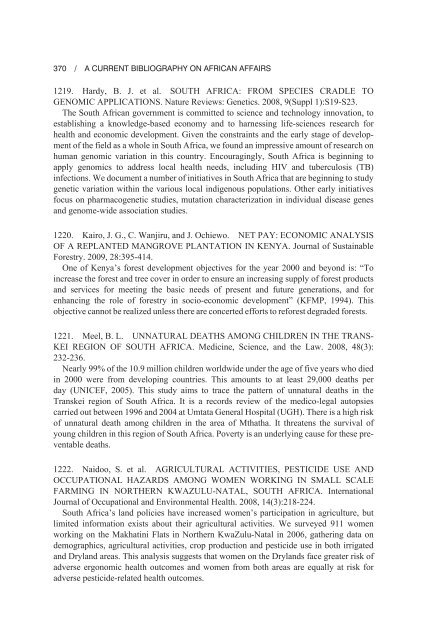A Current Bibliography on African Affairs - Baywood Publishing
A Current Bibliography on African Affairs - Baywood Publishing
A Current Bibliography on African Affairs - Baywood Publishing
You also want an ePaper? Increase the reach of your titles
YUMPU automatically turns print PDFs into web optimized ePapers that Google loves.
370 / A CURRENT BIBLIOGRAPHY ON AFRICAN AFFAIRS<br />
1219. Hardy, B. J. et al. SOUTH AFRICA: FROM SPECIES CRADLE TO<br />
GENOMIC APPLICATIONS. Nature Reviews: Genetics. 2008, 9(Suppl 1):S19-S23.<br />
The South <strong>African</strong> government is committed to science and technology innovati<strong>on</strong>, to<br />
establishing a knowledge-based ec<strong>on</strong>omy and to harnessing life-sciences research for<br />
health and ec<strong>on</strong>omic development. Given the c<strong>on</strong>straints and the early stage of development<br />
of the field as a whole in South Africa, we found an impressive amount of research <strong>on</strong><br />
human genomic variati<strong>on</strong> in this country. Encouragingly, South Africa is beginning to<br />
apply genomics to address local health needs, including HIV and tuberculosis (TB)<br />
infecti<strong>on</strong>s. We document a number of initiatives in South Africa that are beginning to study<br />
genetic variati<strong>on</strong> within the various local indigenous populati<strong>on</strong>s. Other early initiatives<br />
focus <strong>on</strong> pharmacogenetic studies, mutati<strong>on</strong> characterizati<strong>on</strong> in individual disease genes<br />
and genome-wide associati<strong>on</strong> studies.<br />
1220. Kairo, J. G., C. Wanjiru, and J. Ochiewo. NET PAY: ECONOMIC ANALYSIS<br />
OF A REPLANTED MANGROVE PLANTATION IN KENYA. Journal of Sustainable<br />
Forestry. 2009, 28:395-414.<br />
One of Kenya’s forest development objectives for the year 2000 and bey<strong>on</strong>d is: “To<br />
increase the forest and tree cover in order to ensure an increasing supply of forest products<br />
and services for meeting the basic needs of present and future generati<strong>on</strong>s, and for<br />
enhancing the role of forestry in socio-ec<strong>on</strong>omic development” (KFMP, 1994). This<br />
objective cannot be realized unless there are c<strong>on</strong>certed efforts to reforest degraded forests.<br />
1221. Meel, B. L. UNNATURAL DEATHS AMONG CHILDREN IN THE TRANS-<br />
KEI REGION OF SOUTH AFRICA. Medicine, Science, and the Law. 2008, 48(3):<br />
232-236.<br />
Nearly 99% of the 10.9 milli<strong>on</strong> children worldwide under the age of five years who died<br />
in 2000 were from developing countries. This amounts to at least 29,000 deaths per<br />
day (UNICEF, 2005). This study aims to trace the pattern of unnatural deaths in the<br />
Transkei regi<strong>on</strong> of South Africa. It is a records review of the medico-legal autopsies<br />
carried out between 1996 and 2004 at Umtata General Hospital (UGH). There is a high risk<br />
of unnatural death am<strong>on</strong>g children in the area of Mthatha. It threatens the survival of<br />
young children in this regi<strong>on</strong> of South Africa. Poverty is an underlying cause for these preventable<br />
deaths.<br />
1222. Naidoo, S. et al. AGRICULTURAL ACTIVITIES, PESTICIDE USE AND<br />
OCCUPATIONAL HAZARDS AMONG WOMEN WORKING IN SMALL SCALE<br />
FARMING IN NORTHERN KWAZULU-NATAL, SOUTH AFRICA. Internati<strong>on</strong>al<br />
Journal of Occupati<strong>on</strong>al and Envir<strong>on</strong>mental Health. 2008, 14(3):218-224.<br />
South Africa’s land policies have increased women’s participati<strong>on</strong> in agriculture, but<br />
limited informati<strong>on</strong> exists about their agricultural activities. We surveyed 911 women<br />
working <strong>on</strong> the Makhatini Flats in Northern KwaZulu-Natal in 2006, gathering data <strong>on</strong><br />
demographics, agricultural activities, crop producti<strong>on</strong> and pesticide use in both irrigated<br />
and Dryland areas. This analysis suggests that women <strong>on</strong> the Drylands face greater risk of<br />
adverse erg<strong>on</strong>omic health outcomes and women from both areas are equally at risk for<br />
adverse pesticide-related health outcomes.




